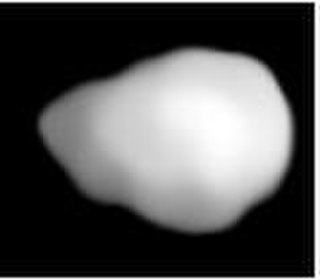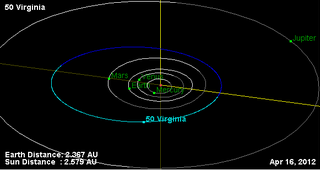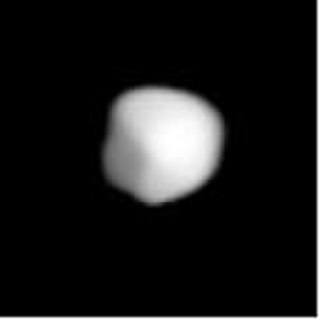
41 Daphne is a large asteroid from the asteroid belt. It is a dark-surfaced body 174 km in diameter is probably composed of primitive carbonaceous chondrites. The spectra of the asteroid displays evidence of aqueous alteration. It was discovered by H. Goldschmidt on May 22, 1856, and named after Daphne, the nymph in Greek mythology who was turned into a laurel tree. Incorrect orbital calculations initially resulted in 56 Melete being mistaken for a second sighting of Daphne. Daphne was not sighted again until August 31, 1862.

50 Virginia is a large, very dark main belt asteroid. It was discovered by American astronomer James Ferguson on October 4, 1857, from the United States Naval Observatory in Washington, D.C. German astronomer Robert Luther discovered it independently on October 19 from Düsseldorf, and his discovery was announced first.

56 Melete is a large and dark main belt asteroid. It is a rather unusual P-type asteroid, probably composed of organic rich silicates, carbon and anhydrous silicates, with possible internal water ice. The asteroid orbits the Sun with a period of 4.18 years.

59 Elpis is a large main belt asteroid that orbits the Sun with a period of 4.47 years. It is a C-type asteroid, meaning that it is very dark and carbonaceous in composition. In the Tholen scheme it has a classification of CP, while Bus and Binzen class it as type B.

69 Hesperia is a large, M-type main-belt asteroid. It was discovered by the Italian astronomer Giovanni Schiaparelli on April 29, 1861 from Milan, while he was searching for the recently discovered 63 Ausonia. It was his only asteroid discovery. Schiaparelli named it Hesperia in honour of Italy. The asteroid is orbiting the Sun with a period of 5.14 years, a semimajor axis of 2.980 AU, and eccentricity of 0.165. The orbital plane is inclined by an angle of 8.59° to the plane of the ecliptic.

72 Feronia is a quite large and dark main belt asteroid. It was the first asteroid discovery by C. H. F. Peters, on May 29, 1861, from Hamilton College, New York State. It was initially thought that Peters had merely seen the already known asteroid 66 Maja, but T.H. Safford showed that it was a new body. Safford named it after Feronia, a Roman fertility goddess.

78 Diana is a large and dark main-belt asteroid. It was discovered by German astronomer Robert Luther on March 15, 1863, and named after Diana, Roman goddess of the hunt. The asteroid is orbiting the Sun at a distance of 2.620 AU with a period of 4.24 years and an eccentricity (ovalness) of 0.207. The orbital plane is tilted at an angle of 8.688° relative to the plane of the ecliptic. Its composition is carbonaceous and primitive.
126 Velleda is a main-belt asteroid. It is probably a rather typical, albeit sizable, S-type asteroid. Named for Veleda, a priestess and prophet of the Germanic tribe of the Bructeri. It was discovered by Paul Henry on November 5, 1872, in Paris, France. It was his first credited discovery. He and his brother Prosper Henry discovered a total of 14 asteroids.

221 Eos is a large main-belt asteroid that was discovered by Austrian astronomer Johann Palisa on January 18, 1882, in Vienna. In 1884, it was named after Eos, the Greek goddess of the dawn, to honour the opening of a new observatory that was hoped to bring about a new dawn for Viennese astronomy.

230 Athamantis is a fairly large main-belt asteroid that was discovered by the German-Austrian astronomer K. de Ball on September 3, 1882, in Bothkamp. It was his only asteroid discovery. The asteroid was named after Athamantis, daughter of Athamas the mythical Greek king of Orchomenus.

240 Vanadis is a fairly large main-belt asteroid with a diameter of around 100 km. It was discovered by A. Borrelly on August 27, 1884, in Marseilles and was named after Freyja (Vanadis), the Norse fertility goddess. The asteroid is orbiting the Sun at a distance of 2.67 AU with a period of 4.35 yr and an orbital eccentricity of 0.206. The orbital plane is inclined at an angle of 2.10° to the plane of the ecliptic.

266 Aline is a fairly large main belt asteroid that was discovered by Johann Palisa on 17 May 1887 in Vienna and is thought to have been named after the daughter of astronomer Edmund Weiss. It is a dark C-type asteroid and is probably composed of primitive carbonaceous material. 266 Aline is orbiting close to a 5:2 mean motion resonance with Jupiter, which is located at 2.824 AU.
356 Liguria is a very large main-belt asteroid that was discovered by Auguste Charlois on January 21, 1893, in Nice. It is one of seven of Charlois's discoveries that was expressly named by the Astromomisches Rechen-Institut, and was named for the Italian region.
455 Bruchsalia is a main-belt asteroid. It was discovered by Max Wolf and Friedrich Karl Arnold Schwassmann on May 22, 1900. Its provisional name was 1900 FG.
488 Kreusa is a C-type asteroid orbiting the Sun in the asteroid belt, with the type indicating a surface with a low albedo and high carbonaceous content. The spectra of the asteroid displays evidence of aqueous alteration.

505 Cava is a minor planet orbiting the Sun.
554 Peraga is a minor planet orbiting the Sun that was discovered by German astronomer Paul Götz on January 8, 1905, from Heidelberg.
654 Zelinda is a minor planet orbiting the Sun that was discovered on 4 January 1908 by German astronomer August Kopff. On favorable oppositions, it can be as bright as magnitude 10.0, as on January 30, 2016.

690 Wratislavia is a minor planet orbiting the Sun. Wratislavia was discovered on October 16, 1909. IRAS data shows it is about 135 km in diameter.
758 Mancunia is a minor planet orbiting the Sun. It was discovered in 1912 from Johannesburg by H. E. Wood, a Mancunian. This object is orbiting at a distance of 3.19 AU with a period of 5.70 years and an eccentricity (ovalness) of 0.15. The orbital plane is inclined at an angle of 5.61° to the plane of the ecliptic.














